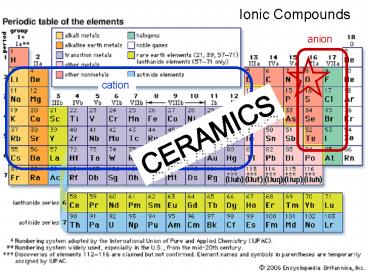cation PowerPoint PPT Presentation
Title: cation
1
Ionic Compounds
anion
cation
Ceramics
2
More Complex Structures
- Multiple cations
- Perovskite ABO3
- Capacitors
- Spinel AB2O4
- Magnetic properties
- Covalency
- Zinc blende
- Semiconductors
- Diamond
- Semiconductors
- Silicates
- Minerals
?
RB lt RA RO
3
Spinel
- Spinel AB2O4 B ? boron
- A2(B3)2O4 MgAl2O4
- Occurs when RA RB lt RO
- CCP array of oxygen anions
- To attain stoichiometry, fill 3 cation sites per
4 anions (¾ 1) - All octahedral 1 1
- 1/2 tetrahedral 1 1
- arrange occupied sites in a regular manner like
zinc blende to keep cations far apart - unit cell is 8x regular CCP unit cell
- A ? B site occupancy ? magnetic properties
1/2 octahedral 1/8 tetrahedral
1/2 cation 1 anion
1/4 cation 1 anion
normal B in oct, A in tet
inverse A B in oct, B in tet
4
Magnetism in Spinel
- unpaired electron spin
- atoms in B-site add
- atoms in A-site subtract
- tune A and B-site occupancy to tune magnetic
behavior - (details given in lecture)
5
Covalent Compounds
sp3
s2p2
s2p4
s2p1
s2p3
s2
semi-conductors
6
Covalent Structures
? both species tetrahedral
Recall zinc blende
ZnS 2 -2 GaAs 3 -3
single element C or Si or Sn
or sp3
4
4
diamond
How many lattice points per unit cell?
7
Brief Review
- Metals
- Close-packed structures (CN 12)
- Cubic close-packed, hexagonal close-packed
- Subtle reasons for selecting one over the other
- Slightly less close-packed
- Body centered cubic (CN 8)
- Influence of covalency
- Ionic structures
- Close-packed with constraints
- Covalent structures
- Not close-packed, bonding is directional
- Any can be strongly or weakly bonded (Tm)
8
Diamond vs. CCP
8 atoms/cell, CN 4
4 atoms/cell, CN 12
½ tetrahedral sites filled
9
Computing density
- Establish unit cell contents
- Compute unit cell mass
- Compute unit cell volume
- Unit cell constant, a, given (or a and c, etc.)
- Or estimate based on atomic/ionic radii
- Compute mass/volume, g/cc
- Example NaCl
- Contents 4 Na 4 Cl
- Mass 4(atom mass Na atomic mass Cl)/No
- Vol a3
- Units
10
Single Crystal vs. Polycrystalline
Rb3H(SO4)2
Ba(Zr,Y)O3-d
Regions of uninterrupted periodicity amalgamated
into a larger compact
Periodicity extends uninterrupted throughout
entirety of the sample External habit often
reflects internal symmetry
grains delineated by grain boundaries
11
Polycrystallinity
PowerShow.com is a leading presentation sharing website. It has millions of presentations already uploaded and available with 1,000s more being uploaded by its users every day. Whatever your area of interest, here you’ll be able to find and view presentations you’ll love and possibly download. And, best of all, it is completely free and easy to use.
You might even have a presentation you’d like to share with others. If so, just upload it to PowerShow.com. We’ll convert it to an HTML5 slideshow that includes all the media types you’ve already added: audio, video, music, pictures, animations and transition effects. Then you can share it with your target audience as well as PowerShow.com’s millions of monthly visitors. And, again, it’s all free.
About the Developers
PowerShow.com is brought to you by CrystalGraphics, the award-winning developer and market-leading publisher of rich-media enhancement products for presentations. Our product offerings include millions of PowerPoint templates, diagrams, animated 3D characters and more.

